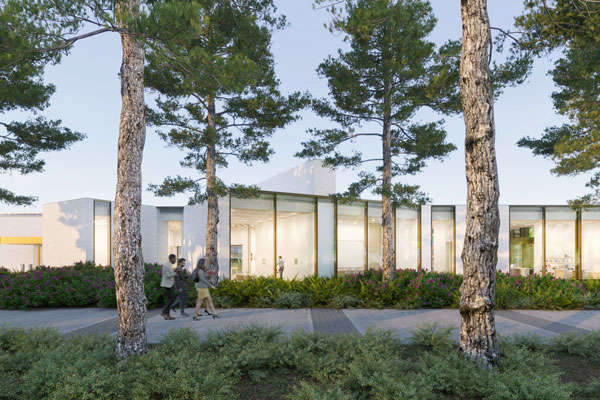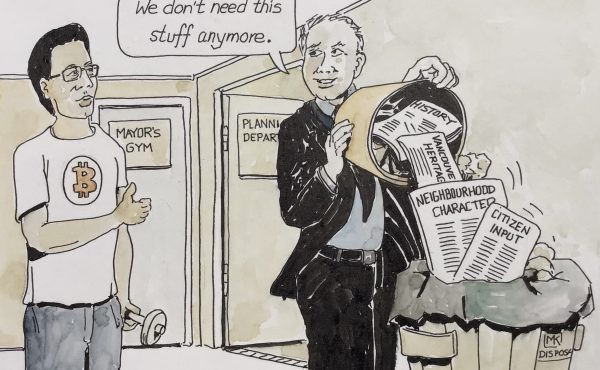Simon Fraser University will open the landmark Marianne and Edward Gibson Art Museum (the Gibson) on Sept. 20, 2025, with the inaugural group exhibition Edge Effects.
The institution marks the beginning of a new cultural legacy for the university, as its first purpose-built art museum that consolidates what was previously known as SFU Galleries. Featuring an award-winning design by Siamak Hariri, founding partner of Toronto-based Hariri Pontarini Architects, in partnership with Vancouver-based Iredale Architecture, the 12,100-square-foot museum is defined by its unique polygonal form and expansive windows that draw in the natural landscape and foster a sense of openness.
“In part inspired by the intelligence of trees and their underground networks of communication and support, the Gibson is a space where art and learning come together to create a vibrant canopy of activity supported by deep connections,” says Kimberly Phillips, director of the Gibson. “My desire for natural light and porosity, for bringing the outside in, stems in part from Dr. Edward Gibson’s own belief, as an urban geographer, in art’s connection to its surroundings and the unique experience of Arthur Erickson’s architecture on the Burnaby campus. Many works in the SFU Art Collection are deeply rooted in this place, reflecting its history and territories. As the new home for this collection, the Gibson deserves to be a space open to the world, allowing the art to engage with the very environment from which it emerged.”
The Gibson’s architectural and design details all highlight this sense of flow and warmth, including the craftsmanship of its intricate brickwork and the decision to have two entrances into the building: one facing the SFU Transit Exchange (main bus loop) and the other toward the campus, which allows visitors to explore seamlessly.
The structure is made from BC-sourced mass timber beams that distinguish the 15-foot-high ceilings. The building is fully electric and LEED Gold certified. Flexible programming spaces feature areas with long tables for farmhouse-style seating and a central hearth that will serve as the home of a new site-specific, semi-permanent installation by Cindy Mochizuki. In addition to the furniture designed locally by Lock & Mortice, there are pieces brought in from international companies, such as fully compostable upholstered lounges from Milan-based Studio Urquiola and the Danish-made bricks that reference Erickson’s favoured concrete but are characterized by a warmer colour.
The inaugural exhibition is titled Edge Effects, a reference to the ecological term “edge effect,” which describes the conditions created where two adjacent ecological communities meet, such as an estuary between a river and the ocean. This results in a rich and complex co-existence between species that would otherwise never have the chance to interact. In this vein, the museum explores its position at the boundary of academia and the public, and the participating artists of the inaugural exhibition consider edges in their practices that challenge disciplinary, material, and historical boundaries.
Edge Effects features a combination of new commissioned works and projects never before seen by audiences in Canada, such as Liz Magor’s still poignant Blue Students/Alumnos en azul (1997). Originally commissioned by INSITE97, the public project centred on photographic portraits of students from the School of Creative and Performing Arts in San Diego, California, and the Preparatoria Federal Lázaro Cárdenas in Tijuana, Mexico, that were placed throughout both cities. The film negatives were pressed with paper covered in iron salts, which converted into positive blue images as they were exposed to sunlight. By the end of the installation period, only a few portraits had not been completely obscured, with the artist stating that the legibility of the images represented the power of circumstance and chance that governs people’s lives.
Cindy Mochizuki’s Arboreal Time is a constellation of more than 40 miniature and medium-sized hand-built porcelain sculptures and yakisugi (preserved charred wood) pine elements that chart a forest of kodama, or tree spirits, mounted above the central hearth and fireplace wall at the Gibson. The work reflects how trees experience the passage of time in a cyclical, non-linear way, and invites visitors to linger in the space while co-existing with these strange creatures.
Lorna Brown will present a major project about easements in Vancouver that has been over a decade in the making, featuring a large-scale wall drawing, soft sculptures, and sound work. Elisa Ferrari is working with SFU’s archive, creating sonic collages that query mythologies about the university’s early, turbulent days using voice recordings of past administrators, faculty, and students.
Sameer Farooq and poet Jared Stanley reconsider the storage spaces of SFU’s Archaeology and Ethnology Museum as a “loom” that catches and holds objects and belongings from vastly different times and places. And Pietro Sammarco, with Liz Toohey-Wiese and Helena Krobath, worked with University Highlands Elementary students over eight weeks to create sound compositions and paintings that explored the path of rainwater down Burnaby Mountain.
Additional artists in Edge Effects are: Justine A. Chambers, Patrick Cruz, Lucien Durey, Germaine Koh, Debra Sparrow, and Jin-me Yoon, as well as several works from the SFU Art Collection. Many of the featured artists have close ties with SFU, as alumni, current students, faculty, and visiting fellows.
The Gibson will open to the public with a family-friendly program on Saturday, Sept. 20 from 2–5pm. Following welcoming remarks, there will be a performance by Lucien Durey, an art studio with kids’ activities, light snacks and refreshments.
On Sunday, Sept. 21, the museum will host an artist talk with Patrick Cruz, Sameer Farooq, and Jared Stanley at 2 pm. Additional programs will be announced closer to the fall, including a clay kodama-making workshop with Cindy Mochizuki, a newly commissioned dance performance by Justine A. Chambers, a Coast Salish weaving workshop, a sound performance with Elisa Ferrari, and the launch of the inaugural exhibition’s publication Holdfast: On Creating the Marianne and Edward Gibson Art Museum this winter.
***
For more information about the museum, visit gibson.sfu.ca. Details about the exhibition will be published online closer to the opening.





2 comments
Hello, Do I need to RSVP for this Saturday, September 20th, event and exhibition opening? Kindly add me to the list if yes! THX. I am a UBC Graduate student in Art History dept.
Hi Violetta!
From what we understand, the opening on September 20th is open and free for the public—no RVSP required. In fact, all of their programming is to be free of charge and open to all. The only RSVP requirement we received was for the media tour that is today.
We hope that helps!